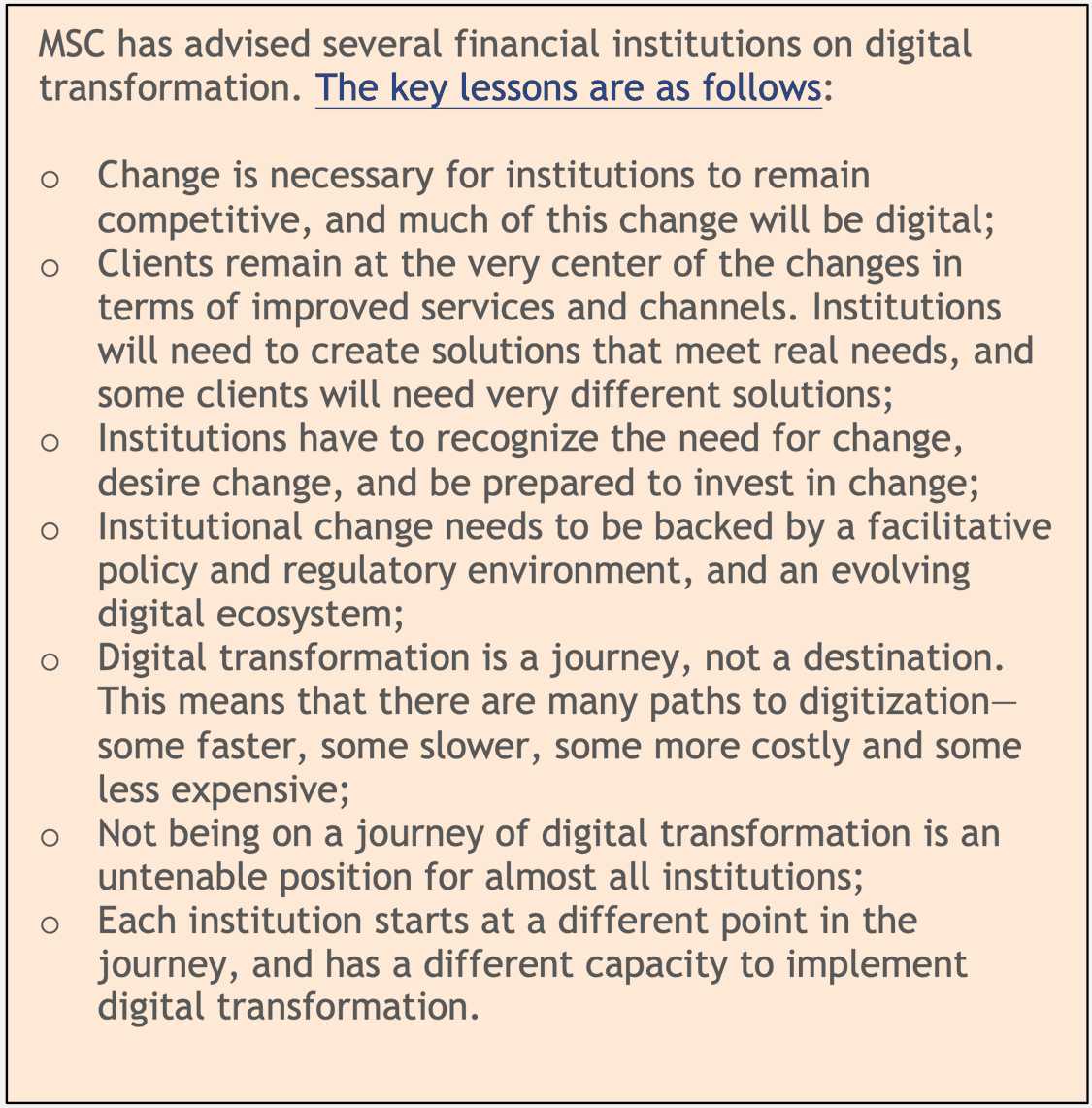Survival, Recovery and Resilience: 12 Recommendations to Help Financial Institutions Weather the COVID-19 Crisis
Philip runs a fruit stall in the City Park market in Nairobi. With his business on the brink of collapse in a now largely empty market, he has lost all hope.
Philip’s circumstances are not unique. He represents over 300 million enterprises from emerging economies across the world. The COVID-19 pandemic has affected the lives, health and livelihoods of countless entrepreneurs, who are struggling to repay loans from financial institutions. These financial institutions, too, are in the middle of a vicious cycle where poor asset quality leads to liquidity pressure and hurts profitability. The crisis may erode a decade of progress in financial access if these institutions do not receive support in time.
The global pandemic also highlights the need (and opportunity) for a digital transformation in response to this crisis, which may persist for years if we fail to develop a fully effective vaccine.
Based on MicroSave Consulting’s (MSC’s) experience working with providers and customers in emerging markets around the world, we’ve compiled some recommendations to help financial institutions survive, recover and revive in the wake of COVID-19. We’ll discuss these 12 recommendations below.
1. Assess the operating environment and the impact of the pandemic on clients and institutions
Financial institutions need to understand their new operating environment if they wish to build survival strategies. They must assess the impact of the pandemic on the financial sector and their clients. This will help them prioritize strategic steps to support their recovery.
This assessment should address the impact of the crisis at an institutional level, including the following elements: a) financial aspects like capital adequacy and funding structure, funding mix and financial instruments to mitigate various risks; b) portfolio aspects such as asset quality, concentration and diversity; c) risk management strategies; and d) aspects of human resources focused on redundancies, impact on staffing levels and the need to retrain staff members to perform other tasks.
2. Build a crisis management unit to make quick and effective decisions
Institutions should build a crisis management unit to tackle challenges both during and after the pandemic. Ideally, the unit should have executive powers and it should be empowered to make proactive decisions. The unit should develop quick strategic and institutional responses to manage immediate and short-term risks.
3. Develop a business continuity plan with scenario analysis to decide on immediate and short-term plans
The development of a business continuity plan across various time frames should be the next step. Financial institutions will need to revise their business plans in light of the emerging situation, build scenarios and refine their budgets accordingly. As part of this process, the institutions may need to optimize expenses, reduce costs and revise the prices of their products.
4. Prioritize the health of clients and staff members
The high-touch model employed by many financial institutions has the potential to expose their staff to the risk of infection. In response, these institutions need to create awareness among their staff members, who must, in turn, try to minimize their risk of infection while serving clients and handling cash. In addition, institutions should train their field staff members to act as community health advisors, to demonstrate good corporate citizenship and care for clients. They should prepare field staff members to educate customers on preventive measures, and to guide any suspected cases to available sites where they can get screened or tested.
5. Engage in internal and external communication to manage expectations and illuminate the way forward for all stakeholders
In the immediate term, financial institutions need to communicate well with their staff, clients, donors, investors and other stakeholders. They may focus on internal communications around restructuring staff members’ roles, ensuring the safety and wellness of their staff, developing strategies for portfolio and risk management, and revising structures and job responsibilities. They may also amplify external communications around the impact of the pandemic on clients, staff and portfolios. These external communications may include business continuity measures, portfolio and risk management measures, and guidance on the institutional response.
6. Consider portfolio management strategies, such as restarting operations, restructuring loans and managing emerging risks
Financial institutions may consider restarting operations in less infected areas to revive their portfolios. They may also consider portfolio planning and management through a mix of segmentation, risk analysis and stress-testing scenarios.
As the pandemic has affected most clients, institutions may need to restructure and refinance client loans to enable their clients to use additional credit for business recovery. However, these institutions should use a segment-wise portfolio analysis, in which they identify which segments of their portfolio have been less impacted by the pandemic and therefore have greater potential for repayment. This can help them determine which clients are eligible for restructuring of loans.
7. Source new funding to enhance recovery initiatives
Financial institutions will need new funding strategies to accelerate their path to recovery. In developing these strategies, they will need to reposition the institution to rebuild after the pandemic, and understand the current priorities of donors and investors. Institutions may also identify key government support programs for the financial sector, raising funds for the recovery phase by utilizing government programs as well as donor and investor capital.
8. Digitize to recover and build resilience
Digital transformation offers the right combination of solutions or tools delivered digitally to provide a seamless user experience. Financial institutions should take advantage of the opportunity the crisis presents to digitize their business models and operations. An increasing number of financial institutions are now gearing up their efforts towards digital transformation and will quickly eat into the markets of analog financial institutions.
However, financial institutions need to customize and contextualize their strategies for digital transformation. They may need to develop unique, individual and customized digital solutions that move past the current limitations of using physical touchpoints.
9. Formulate and implement radically altered strategies, new product lines, and new revenue streams to build long-term resilience
In the next phase of post-COVID recovery, institutions will need to transform radically to build resilience based on their level of preparedness, the macro-economic conditions they operate in and the context.
As part of these revival and resilience-building efforts, institutions may develop a new product mix, such as new credit lines and innovative savings schemes geared to insulate clients against future disasters. Further, they may build partnerships to offer products like wholesale lending credit lines to revive businesses.
10. Enhance risk assessment and management to speed up the revival process
Financial institutions will need to enhance their approaches to risk management significantly, especially for credit portfolios. This can be done through the identification of existing and new risks, the assessment of the nature of these risks, and the validation of the existing risk management framework. Institutions may need to re-calibrate the indicators and triggers of all these risks in line with their shocks and impact on their portfolios. They might also need to refine the approaches to institutional risk management and mitigation measures.
11. Build staff capacities to operate in the new business environment in the post-pandemic world
Financial institutions can develop and disseminate content to better prepare their staff to work in the new, post-COVID business environment. These modules can comprise lessons in the form of interactive sessions that include experience sharing. Further, institutions may also enhance their employees’ preparedness to manage shocks that may impact the business operations of clients in the future.
12. Boost the skills and capacities of clients to help build resilience and nudge them to adopt digital products and alternative channels
Financial institutions need to ensure regular client engagement through the use of digital client management platforms. They may also help individuals and enterprises build skills and capacities through access to training modules. These modules can include lessons on digital capability and financial education for individuals, and business skills for entrepreneurs. Such skills and capacity-building measures may encourage clients to adopt digital products and alternative channels.
Financial institutions can use the 12 measures discussed above to align their business operations with the needs of their users, and to better utilize digitization to deliver client-centric solutions. In addition, these measures would enable them to recover faster from the current social and economic crises, and to formulate a better response to future disruptions. If they act on these recommendations, these institutions would, in turn, be able to better support enterprises and boost their recovery, thereby also accelerating the recovery of the broader economy in emerging markets. This would present a ray of hope for Philip and other entrepreneurs like him – and it’s a compelling reason why investors, donors and other sector stakeholders should support financial institutions in their efforts to revive and re-engineer.
Anup Singh leads MicroSave’s Inclusive Finance and Banking domain and is a key contributor to the research working group. Graham A.N. Wright founded MicroSave and is currently its group managing director. Microsave (MSC) is a NextBillion partner.
Photo courtesy of Martin Heigan.
- Categories
- Coronavirus, Finance




